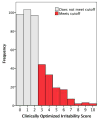Identifying Clinically Significant Irritability in Early Childhood
- PMID: 29496128
- PMCID: PMC5860673
- DOI: 10.1016/j.jaac.2017.12.008
Identifying Clinically Significant Irritability in Early Childhood
Abstract
Objective: Advances in developmentally sensitive measurement have enabled differentiation of normative versus clinically salient irritability in early childhood. However, clinical application of these measures is still nascent. The authors developed an optimized model of clinically salient irritable behaviors at preschool age. Based on this model, the authors derived an empirically based cutoff in relation to concurrent DSM-5 irritability-related disorders (i.e., oppositional defiant disorder, disruptive mood dysregulation disorder, other depressive disorders) and used longitudinal models to test the predictive validity of the cutoff for impairment and irritability trajectories and later DSM disorders.
Method: Preschool children oversampled for irritability were followed over 3 time points into early school age (N = 425; mean age at baseline 4.7 years, mean follow-up 2.9 years). Mothers reported on children's irritability using the developmentally validated Multidimensional Assessment of Profile of Disruptive Behavior (MAP-DB) Temper Loss scale, impairment using the Family Life Impairment Scale, and DSM categories using the Preschool Age Psychiatric Assessment and the Schedule for Affective Disorders and Schizophrenia-Present and Lifetime Version.
Results: Of 22 MAP-DB Temper Loss behaviors, 2 behaviors-1 normative (easily frustrated) and 1 rare dysregulated (destructive tantrums)-were uniquely related to cross-domain impairment. At baseline, these 2 irritability items identified diagnostic status (oppositional defiant disorder, disruptive mood dysregulation disorder, other depressive disorders) with good sensitivity (70-73%) and specificity (74-83%). Children above the irritability cutoff at baseline also exhibited more persistent irritability and impairment and greater likelihood of DSM disorders in early school age.
Conclusion: Clinical identification of early-onset irritability can be enhanced using brief, developmentally optimized indicators. Further research to apply these findings to tiered early intervention is important.
Keywords: developmental psychopathology; disruptive mood dysregulation disorder; irritability.
Copyright © 2018 American Academy of Child and Adolescent Psychiatry. All rights reserved.
Figures



Comment in
-
Pediatric Irritability Comes of Age.J Am Acad Child Adolesc Psychiatry. 2018 Mar;57(3):149-150. doi: 10.1016/j.jaac.2017.12.014. J Am Acad Child Adolesc Psychiatry. 2018. PMID: 29496122 No abstract available.
Similar articles
-
Toward a Developmental Nosology for Disruptive Mood Dysregulation Disorder in Early Childhood.J Am Acad Child Adolesc Psychiatry. 2021 Mar;60(3):388-397. doi: 10.1016/j.jaac.2020.04.015. Epub 2020 Jun 27. J Am Acad Child Adolesc Psychiatry. 2021. PMID: 32599006 Free PMC article.
-
Clinical Implications of a Dimensional Approach: The Normal:Abnormal Spectrum of Early Irritability.J Am Acad Child Adolesc Psychiatry. 2015 Aug;54(8):626-34. doi: 10.1016/j.jaac.2015.05.016. Epub 2015 Jun 14. J Am Acad Child Adolesc Psychiatry. 2015. PMID: 26210331 Free PMC article.
-
Contextual variation in young children's observed disruptive behavior on the DB-DOS: implications for early identification.J Child Psychol Psychiatry. 2015 Sep;56(9):1008-16. doi: 10.1111/jcpp.12430. Epub 2015 Jun 12. J Child Psychol Psychiatry. 2015. PMID: 26095766 Free PMC article.
-
Focus on Disruptive Mood Dysregulation Disorder: A review of the literature.Psychiatry Res. 2019 Sep;279:323-330. doi: 10.1016/j.psychres.2019.05.043. Epub 2019 Jun 1. Psychiatry Res. 2019. PMID: 31164249 Review.
-
[Disruptive Mood Dysregulation Disorder: a controversial new diagnostic entity in the DSM-5].Z Kinder Jugendpsychiatr Psychother. 2017 Mar;45(2):98-103. doi: 10.1024/1422-4917/a000496. Epub 2016 Nov 17. Z Kinder Jugendpsychiatr Psychother. 2017. PMID: 27855560 Review. German.
Cited by
-
Prefrontal modulation of frustration-related physiology in preschool children ranging from low to severe irritability.Dev Cogn Neurosci. 2022 Jun;55:101112. doi: 10.1016/j.dcn.2022.101112. Epub 2022 May 3. Dev Cogn Neurosci. 2022. PMID: 35576725 Free PMC article.
-
Toward an optimized assessment of adolescent psychopathology risk: Multilevel environmental profiles and child irritability as predictors.JCPP Adv. 2023 Jun 13;3(4):e12180. doi: 10.1002/jcv2.12180. eCollection 2023 Dec. JCPP Adv. 2023. PMID: 38054055 Free PMC article.
-
Multi-method assessment of irritability and differential linkages to neurophysiological indicators of attention allocation to emotional faces in young children.Dev Psychobiol. 2020 Jul;62(5):600-616. doi: 10.1002/dev.21930. Epub 2019 Oct 20. Dev Psychobiol. 2020. PMID: 31631345 Free PMC article.
-
Concurrent and prospective associations between infant frontoparietal and default mode network connectivity and negative affectivity.Biol Psychol. 2023 Nov;184:108717. doi: 10.1016/j.biopsycho.2023.108717. Epub 2023 Nov 3. Biol Psychol. 2023. PMID: 37924936 Free PMC article.
-
Preschool Irritability Predicts Adolescent Psychopathology and Functional Impairment: A 12-Year Prospective Study.J Am Acad Child Adolesc Psychiatry. 2022 Apr;61(4):554-564.e1. doi: 10.1016/j.jaac.2021.08.016. Epub 2021 Sep 2. J Am Acad Child Adolesc Psychiatry. 2022. PMID: 34481916 Free PMC article.
References
Publication types
MeSH terms
Grants and funding
LinkOut - more resources
Full Text Sources
Other Literature Sources
Miscellaneous

